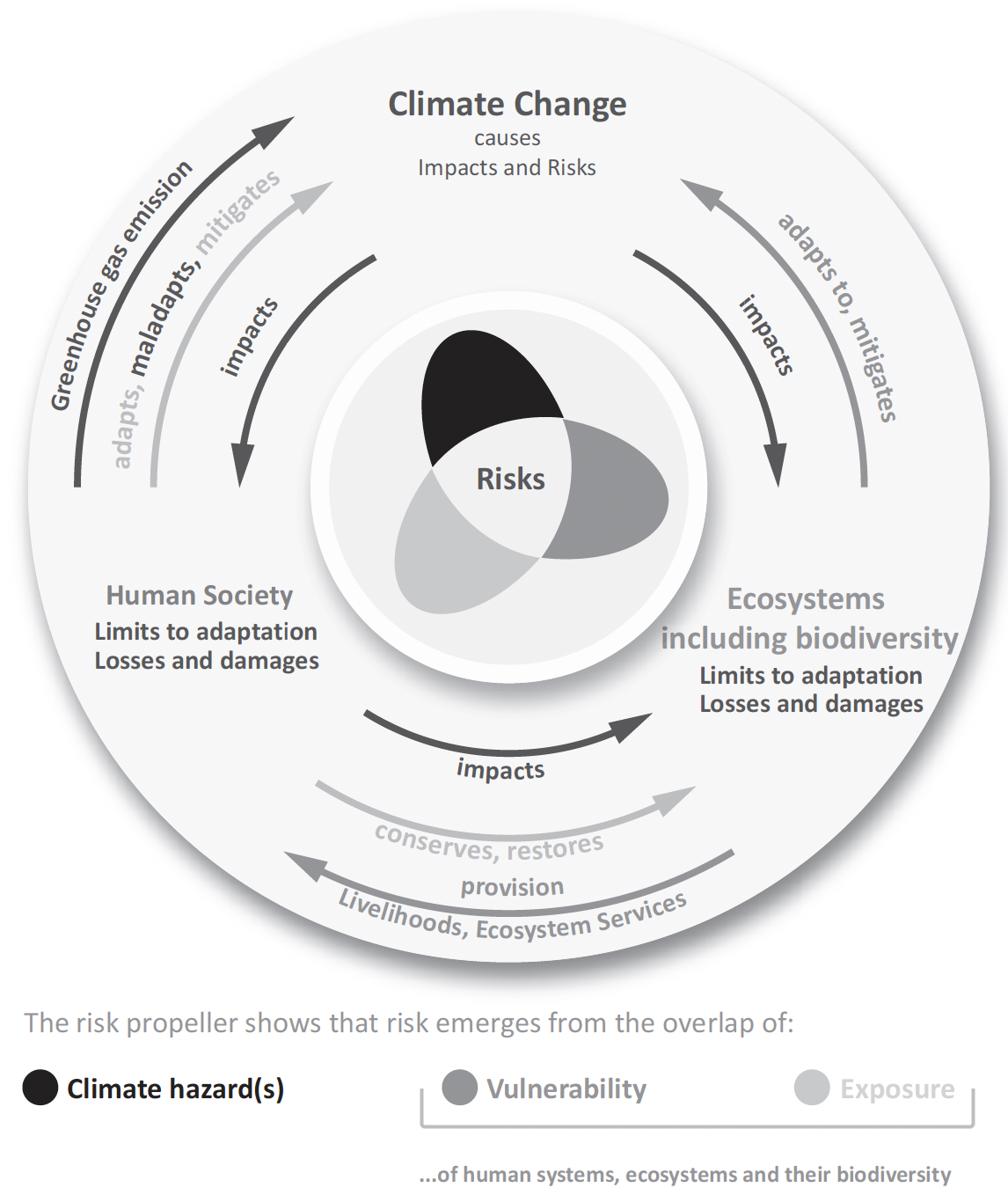Lecture 27
Climate Change III: Adaptation
November 11, 2024
Climate Change III: Adaptation
Introduction: The Role of Adaptation Policy
Mitigation Policies: Necessary but Not Sufficient
- Mitigation: Reducing greenhouse gas emissions.
- Important tools for reducing emissions.
- Absolutely necessary to combat climate change.
- Limitations of Mitigation:
- Cannot prevent all climate change impacts.
- Tipping points have been reached; some impacts are unavoidable.
Introduction: The Role of Adaptation Policy
Necessity of Adaptation

Perspectives on Climate Vulnerability and Risk
- Adaptation: Adjusting to actual or expected climate and its effects.
- Manages risks from unavoidable climate modifications.
- Complements mitigation efforts.
Definition of Adaptation (IPCC, 2018)
- In Human Systems
The process of adjustment to actual or expected climate and its effects, in order to moderate harm or exploit beneficial opportunities.
- In Natural Systems
The process of adjustment to actual climate and its effects; human intervention may facilitate adjustment to expected climate and its effects.
Types of Adaptation Policies
- Proactive Policies
- Definition: Actions taken in anticipation of climate change impacts.
- Examples:
- Building sea walls before sea levels rise.
- Implementing drought-resistant agricultural practices.
- Reactive Policies
- Definition: Actions taken in response to climate change impacts that have already occurred.
- Examples:
- Rebuilding after a flood.
- Providing relief aid after wildfires.
Types of Adaptation Policies
The Challenge
- Reactive policies have been the most common but are becoming very expensive.
- Need to prioritize proactive policies to manage increasing risks.
Prioritizing Proactive Adaptation Policies
Vulnerability Assessment
- Purpose: Determine who and what is at risk, and to what extent.
- Components:
- Hazards: Driven by climate changes (e.g., sea level rise, storms).
- Exposure: The degree to which a system is exposed to hazards.
- Vulnerability: Socio-economic conditions influencing the ability to cope.
Prioritizing Proactive Adaptation Policies
“Climate change, through hazards, exposure, and vulnerability generates impacts and risks that can surpass limits to adaptation and result in losses and damages.” IPCC (2022) Statement
- Context-Specific Adaptation
- Adaptation policies must be tailored to specific locations and contexts.
- Capacity to Adapt varies:
- High Capacity: The Netherlands with resources and experience.
- Low Capacity: Poor island nations with fewer resources.
Adaptation and Mitigation: Complements or Substitutes?
- Complementary Strategies
- Optimal Policy Response includes both adaptation and mitigation.
- Upward-Sloping Marginal Cost Functions:
- Employing both strategies minimizes total costs.
- Deviating increases costs unnecessarily.
- Substitutability
- More of One Means Less of the Other:
- Higher investment in mitigation can reduce the need for adaptation, and vice versa.
- Economic Analysis:
- Optimal investment where MC = MB.
- More of One Means Less of the Other:
Adaptation and Mitigation: Complements or Substitutes?
Misconceptions
- False Choice: It’s not about choosing either mitigation or adaptation.
- Not Perfect Substitutes:
- Adaptation is location-specific.
- Mitigation has global effects.
Timing Differences Between Strategies
“There is a need for an integrated portfolio of actions ranging from avoiding emissions (mitigation) to coping with impacts (adaptation) and to consciously accepting residual damages.”, World Bank
- Mitigation Timing
- Needs Early Implementation:
- Prevents emissions from accumulating.
- Avoids reaching irreversible thresholds.
- Needs Early Implementation:
- Adaptation Timing
- Can Vary:
- Some actions need early implementation.
- Others can wait until more information is available.
- Can Vary:
Economic Tools for Adaptation Decision-Making
- Benefit-Cost Analysis (BCA)
- Evaluate the economic efficiency of adaptation strategies.
- Process:
- Quantify costs of actions.
- Quantify benefits in terms of damage reductions.
- Compare to determine net benefits.
- Cost-Effectiveness Analysis
- Identify the least-cost method to achieve a specific objective.
- Useful When:
- Benefits are hard to quantify monetarily.
- Comparing different strategies to achieve the same goal.
- Efficient Adaptation: Minimize Climate Damage & Costs of Adaptation
Forms of Adaptation Strategies
Public Strategies
- Infrastructure Changes:
- Building sea walls.
- Enhancing flood defenses.
- Policy Measures:
- Zoning laws.
- Building codes.
Private Strategies
- Behavioral Shifts:
- Reducing water waste.
- Planting drought-resistant crops.
- Relocation:
- Moving to less vulnerable areas.
Increasing Costs of Climate Disasters
Trends in Climate Disasters
- Frequency and Intensity Increasing:
- More people affected.
- Higher economic damages.
Factors Exacerbating Damages
- Increased Exposure:
- More people living in vulnerable areas (e.g., floodplains).
- Higher Vulnerability:
- Socio-economic conditions limiting adaptation capacity.
Forms of Adaptation Strategies
Number and Cost of Billion-Dollar Disasters
| Period | Annual Average Cost | Average Events per Year |
|---|---|---|
| 1980-2020 | $45.7 billion | 7.0 |
| 2011-2020 | $89.0 billion | 13.5 |
| 2016-2020 | $121.3 billion | 16.2 |
2020 was the 4th-highest annual costs ($95.0 billion)
Flooding causes more damage and impacts more people worldwide than any other natural disaster.
- Hurricane Ida in 2021 caused $75 billion
- Hurricane Ian in 2022 caused $113 billion
The Role of Adaptation Policy
The Imperative of Adaptation
- Climate Change Impacts are Unavoidable:
- Adaptation is essential to manage risks.
- Complementary Approaches:
- Combining mitigation and adaptation is the most effective strategy.
- Economic Analysis is Vital:
- Helps prioritize and implement efficient adaptation measures.
The Role of Adaptation Policy
Moving Forward
- Proactive Policies:
- Invest in anticipatory actions to reduce future damages.
- Context-Specific Solutions:
- Tailor adaptation strategies to local needs and capacities.
- Global Collaboration:
- Share knowledge and resources to enhance adaptation efforts worldwide.